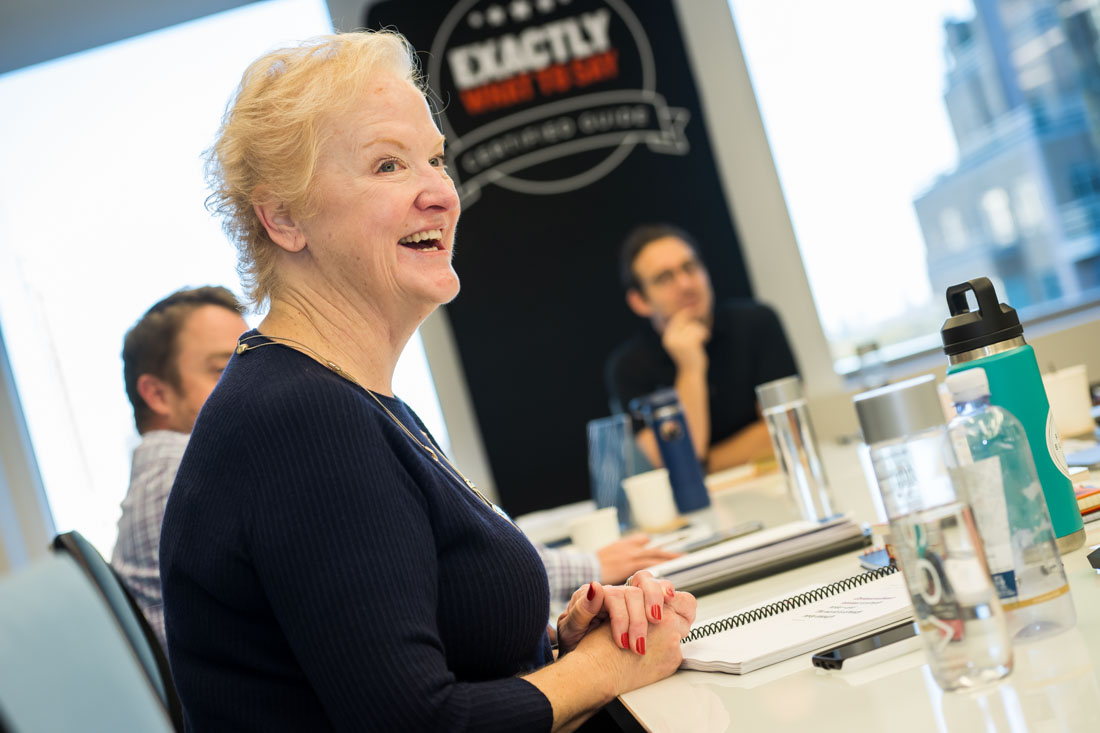EWTS Founder, Phil M Jones, has said that “Conversation with self is probably the most critical conversation that any one of us can have.” Knowing the best way to prompt your internal dialogue can only benefit how your external dialogue goes. My approach to this work from a self-talk perspective offers a simple and effective way to prompt more positive mindsets and internal conversation.
The Four Cornerstones Of Effective Self Talk
When encountering the Exactly What to Say® communication framework, it is important to remember that it takes time to weave the magic words and phrases into the interactions and conversations in your life. It is truly a work in progress.
But what happens when you have made progress with the work? When you have found success with the work, sometimes it can be difficult to see where else you can implement it. The good news is that this framework is meant to be stretched and tested. That was and is the vision Phil had for the Exactly What to Say® Certified Guide community.
Having played with, taught, spoken on, and used this material, I recently realized that I was subconsciously using it for my internal dialogue. Spoiler alert, it had the same compounding positive effect as the improvement in my external communication.
You see, I used to be a jaded person. I could rattle off 10 potential negative outcomes for every 2 positive. I had an edge to my personality that defaulted to pessimism. I walked around with a pretty substantial chip on my shoulder, projecting and assuming in a lot of interactions.
But then, one day, the pessimism went away. The chip disappeared. That all-to-familiar jaded feeling was suddenly absent.
I realized that it was because I started asking questions of myself. Why I felt a certain way. Second guessing long held beliefs. Simply asking, “Could it be possible to think about this differently?”
So, I tried to reverse engineer how I arrived at this point. I went back through all of my notes and the Exactly What to Say® material to see how I could create a path for others to have better internal communication. This first part covers the adjustment of “The Four Cornerstones of Conversational Excellence” to become “The Four Cornerstones Of Effective Self Talk”.
Cornerstone #1
The best time to think about the way you feel about something is in the moment you’re feeling it
We tend to avoid processing both positive and negative interactions for a variety of reasons. We take positive interactions for granted and we avoid confronting the negative with the idea that we will address them later. With a simple mental check-in using curiosity, we can download the feelings we have toward an interaction and add intentionality to why we felt that way.
Cornerstone #2
Self-discovery is a superpower
Just as curiosity is a superpower with conversational excellence, self-discovery is the same for effective self-talk. You want to be able to know exactly where your mindset is so you can be present and intentional in your thoughts. Knowing how you feel going into an interaction gives you the ability to create context around your approach.
Cornerstone #3
You do things for your own reasons, not theirs
It is important to give the same amount of respect to the reasons you do things as you do for others. Understanding the motivations behind your thoughts and feelings will create a higher level of focus and managed expectations.
Cornerstone #4
The person asking themselves questions controls their mindset
We often find ourselves in anxiety causing feedback loops because we allow the same narrative to play out in our mind. We encounter a familiar situation or interact with someone, and we play the tape in our mind of how we should feel based on past experiences. To regain control of your mindset, the same way you can regain control of a conversation, start asking yourself questions. By challenging yourself and disrupting the pattern of behavior, you will open up new and positive avenues of your thinking.
Identifying Critical Self-Talk Conversations
Could it be possible that the most critical conversation in your life on a daily basis is with yourself? An often overlooked piece of personal and professional development training is how it translates internally. We apply new methods of communication but lack the ability to effectively process the information after the fact. We introduce new habits and systems yet struggle to reconcile how it affects our internal dialogues.
The good news is that the Exactly What to Say framework can work to create effective and positive self-talk to disrupt patterns, increase your ability to process information, and build confidence while controlling post-conversation anxiety.
The first Cornerstone of Effective Self-Talk is the best time to think about the way you feel about something is in the moment you’re feeling it. Just like with the first Cornerstone of Conversational Excellence, the key to success is identifying Critical Conversations, Common Objections, and Later Today items. In the case of this framework, we are identifying Critical Self-Talk Conversations, Common Negative Thoughts, and Future Mindsets.
Identify Critical Self-Talk Conversations: Situational mindsets that appear on repeat, when the attitude/focus you bring to these thoughts has a compounding effect on your ability to process information.
Avoid being blindsided by things that you know will happen and when they will happen. Whether it is a certain person you are interacting with or a situation that elicits a certain response, you want to add intentionality to your focus and attitude to have a better inner dialogue as you process information.
Identify Critical Self-Talk Conversations
Situational mindsets that appear on repeat, when the attitude/focus you bring to these thoughts has a compounding effect on your ability to process information.
Avoid being blindsided by things that you know will happen and when they will happen. Whether it is a certain person you are interacting with or a situation that elicits a certain response, you want to add intentionality to your focus and attitude to have a better inner dialogue as you process information.
Identify Common Negative Thoughts
The feedback loops and mental blocks that prevent you from finding optimism/hope while undermining your ability to process information.
We often find ourselves playing the same tape in our heads over and over again. These internal narrative reruns cause us to self-sabotage or erode the ability to be positive. The goal here is to disrupt counterproductive patterns of thinking by knowing what these thoughts and loops are before they happen.
Prepare For Future Mindsets
The situations/interactions you know you will encounter later in your day/week/month where managing expectations and anticipating levels of success could help your ability to react and be present.
Just as our day can be challenged by an afternoon phone call we did not prepare for; we can set ourselves up for failure by not anticipating what our expectations are or levels of success for future interactions. By knowing what could be coming around the corner and preparing by having effective self-talk, you can maintain a positive and productive mindset.
Rewiring the way you think and talk to yourself is not easy. Give yourself grace and space to allow growth without frustration. Work on this intentionally and pay attention to the challenges and victories.
The Critical Ingredients To Effective Self-Talk
I bet you are a bit like me and find yourself having digested hours of training or reading material just like this then not knowing how to implement it in real-world situations. The good news is that, just like the original Exactly What to Say® framework, this internal dialogue toolkit comes with a similar workflow – but I would like to refer to it as more of a mind flow.
These Critical Ingredients are essential for achieving effective and positive self-talk. And just like the most particular baking recipes, it is crucial to add them in a proper order and intentionally measured. Our goal with this is to process information effectively so that we can balance our expectations. Just like the “Courage to Act” with the Critical Ingredients of Influential Conversations, having “Balanced Expectations” allows you to have confidence for every interaction in your life.
Start with Curiosity
When you find yourself needing to begin the processing of a feeling, interaction, or upcoming conversation, the only way to think about how you feel about something is to ask yourself questions. We want to move away from the same broken record internal dialogues and self-sabotaging narratives and focus on exactly why we feel the way we do in the moment.
This leads to Self-Discovery
Earlier, I talked about the Cornerstone of “You do things for your own reasons, not theirs.” This part of the mind flow helps to bring clarity and certainty to what those reasons are. Once you define those reasons, you can attach them to this particular feeling, interaction, or upcoming conversation. This helps to create a future muscle memory as you process these feelings and information over time. You will be able to recall with certainty how you felt as a result of this situation.
This creates your Focus
Instead of being bogged down by feedback loops and past narratives, we have created certainty through curiosity and self-discovery. Because of this, we can simply focus on the feelings and information at hand, not unrelated variables which can lead to anxiety and an inability to know what you are trying to process. Focus allows you to evaluate the situation and you can begin to start processing your thoughts and feelings.
Now, you can evaluate your potential outcomes and Levels of Success
An important part of having an effective dialogue with yourself is being able to admit that things can go really well or not as we planned. Sometimes, we find ourselves focused solely on the negative or being overly optimistic. Defining your levels of success puts into words what could happen as a result of the feeling, interaction, or conversation. By verbalizing the best case, more likely case, and the worst case, you are aware of what could go right and wrong.
This now defines your Mindset
Our mindset can be our worst enemy. By logic, it can also be our biggest ally. I challenge you to picture your mindset as a load-bearing pillar of your ability to have effective internal dialogues. Your mindset is defined by the certainty you created by being curious which led to a focus and ability to anticipate levels of success. You now know how to have the foundation to interact without fear of not being able to reconcile feelings or process information. You are ready to move forward with your thoughts and self-talk – ready to take on the next interaction in your life.
You can now have Balanced Expectations
I hear a lot of people talk about “managing” expectations. For me, expectations feel like a balancing act. You want to be able to know as many potential positive outcomes as negative. Having an imbalance of expectations usually derives from not being able to focus on all likely scenarios due to previous negative experiences leading to feedback loops and false narratives. But having a clear focus, you can take a step back and evaluate the big picture. It also means that by identifying all likely outcomes, you can be prepared for those feelings as they happen.
Remember, these ingredients are important in both order and measure. Do not skip parts or give less attention to certain steps. It is a work in progress, and it will take time to create that muscle memory but when you finally do, it will make a tremendous difference in your life.











